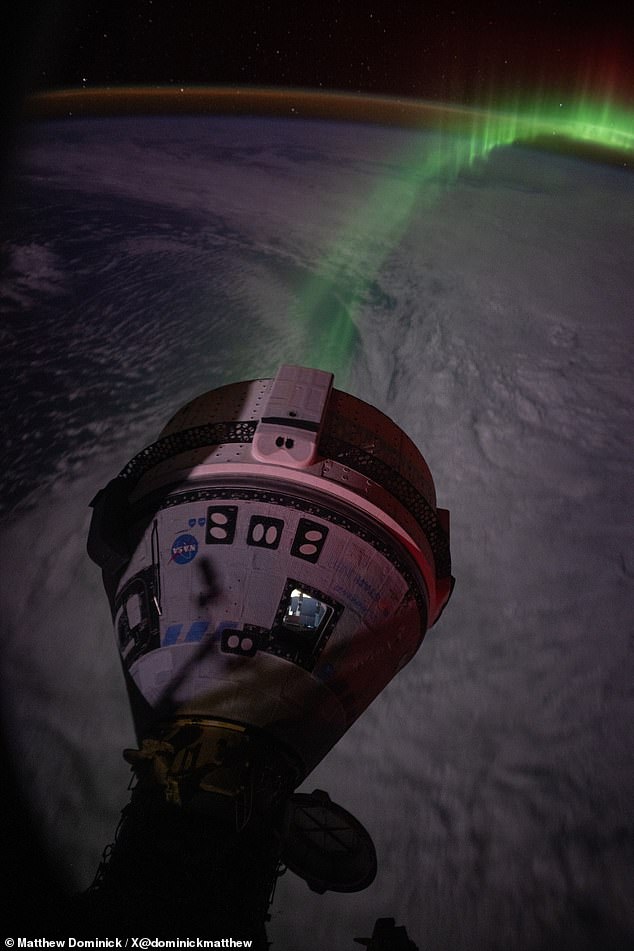


As his time on the International Space Station (ISS) comes to an end, NASA astronaut Matthew Dominick has been treating us with breathtaking images of Earth. His recent post on Twitter features a picture of Cairo and the Mediterranean region illuminated by moonlight. He also captured red sprites - a rarely seen electrical phenomenon - during his approach to Africa. Dominick, along with three other astronauts, is scheduled to return to Earth on Thursday, but their departure could be delayed due to bad weather conditions.
NASA Astronaut Captures Stunning Images of Earth from International Space Station
NASA astronaut Matthew Dominick has been sharing breathtaking images of Earth from his vantage point on the International Space Station (ISS) as his mission nears its end.
Cairo by Moonlight
One of Dominick's recent posts on Twitter features a captivating image of Cairo and the Mediterranean region bathed in moonlight. The city lights illuminate the landscape, creating a mesmerizing view of the ancient metropolis.
Red Sprites over Africa
During his approach to Africa, Dominick also captured a rare electrical phenomenon known as red sprites. These transient luminous events occur high in the atmosphere above thunderstorms and appear as red or orange flashes of light.
Return to Earth Delayed
Dominick is scheduled to return to Earth on Thursday, along with three other astronauts. However, their departure could be postponed due to unfavorable weather conditions at the landing site.
Background
The ISS is an international research facility located in low Earth orbit. It has been continuously inhabited by astronauts since 2000 and has hosted astronauts from over 15 countries.
Matthew Dominick is an American astronaut and physician who was selected to join the NASA Astronaut Corps in 2008. He completed his first spaceflight in 2022 and is currently serving as a member of Expedition 68/69 on the ISS.
Top 5 FAQs and Answers
1. What is the International Space Station (ISS)? It is a modular space station in Earth's orbit, serving as a research and technology development platform for over 20 countries.
2. Who built the ISS? The ISS was constructed through the collaboration of 15 countries, including the United States, Russia, Japan, Canada, and the European Space Agency.
3. How long has the ISS been in orbit? The ISS has been continuously inhabited by astronauts since 2000, making it the longest-duration human presence in space.
4. What kind of research is conducted on the ISS? The ISS is used for a wide range of research, including studies on human spaceflight, microgravity, and Earth observation.
5. When will the ISS be decommissioned? The ISS is currently planned to be decommissioned in 2031, with plans to relocate its operations to a commercial space station.

India's Minister of Petroleum and Natural Gas, Hardeep Singh Puri, is exploring projects in Norway, where the government is funding the largest carbon storage project in the country. This aligns with India's ambitious energy transition agenda. The project involves capturing CO2 emissions from industrial sources and storing them underground, which can help decarbonise industries and mitigate climate change.

A recent study published in The BMJ found that intermittent fasting might be just as effective as traditional calorie-restricted diets, particularly for those with pre-existing health conditions. Despite the limitations of the study, which focused on trials lasting less than 24 weeks, it provides some indication that intermittent fasting can result in weight loss and improved cardiometabolic risk factors. However, the study authors caution that longer-term research is needed to confirm these effects.

Scientific research has found that consistent meditation can provide numerous physical and mental health benefits. By focusing one's attention and letting thoughts come and go without judgment, meditation can reduce stress, anxiety, and depression, while also improving focus, concentration, and sleep quality. Even brief daily meditation sessions have been found to have positive effects on mood and cognitive function, making it a valuable tool for anyone new to the practice or looking to manage their mental health.

"Kerala's Nipah Contact List Surges to 425, Health Workers and Isolation Measures Strengthened" The Nipah contact list in Kerala has reached a staggering 425 individuals, with Malappuram district recording the highest number of contacts. 12 individuals in Malappuram and one in Palakkad are currently undergoing treatment, with a special focus on mental health support for the public. In a high-level review meeting, it was decided that only samples from contacts would be tested in Palakkad and measures such as ambulance readiness and contact tracing intensified.

A team of archaeologists from the Vindolanda Charity Trust in northern England has discovered a collection of Roman shoes, all measuring over 30 centimeters long, at the Magna Roman Fort in Northumberland. These "giant" shoes, equivalent to size 49 in Europe and size 15 in the US, have left experts baffled as they search for an explanation for their unusual size. The team is now speculating on who may have worn these shoes, and what their presence at this particular site may signify. This discovery sheds new light on the daily life of Roman soldiers stationed at the Hadrian's Wall World Heritage Site.

"India's Young Cricket Captain Leads the Way: Breaking Records and Comparisons to Legends" Shubman Gill has stepped up as the new captain of the Indian cricket team and proves he is turning out to be a star in his own right. In just his 34th Test, Gill surpassed Sachin Tendulkar's highest score and has outperformed Virat Kohli as well. His leadership skills and batting prowess have earned him recognition and praise from fans and even exhausted opponents. Despite criticism, Gill stayed true to his own tactics and proved himself with an epic inning of 269. He has set a high standard for himself and the Indian team as they continue the series against England.

WHO has released its first-ever global guideline on managing sickle cell disease (SCD) during pregnancy, highlighting the dangers faced by women and their babies. SCD is an inherited blood disorder with potentially fatal consequences, and the health risks intensify during pregnancy. The new guideline aims to improve outcomes for pregnant women with SCD and calls for more investment in evidence-based treatments and disease awareness. With SCD on the rise globally, increasing numbers of maternity care providers need to be equipped to handle its challenges.

On Thursday, March 19 at 5:01 a.m. ET, the vernal equinox or the first day of spring will take place in the Northern Hemisphere. This marks the beginning of the season of longer days and warmer weather as the sun's rays fall directly on the equator. Despite popular belief, day and night are not exactly the same length on the equinox due to atmospheric refraction. The summer and winter solstices and the autumnal equinox also have significant impacts on the Earth's tilt and the length of daylight hours.

A new, inexpensive Arduino-based logger has been developed for accurately mapping the depths of water bodies. By using budget-friendly hardware such as a GPS module and an SD card, combined with a standard NMEA capable echolot sounder, this device is accessible and practical for scientists, recreational enthusiasts, and more. With the added use of Python and matplotlib, users can now easily transform the collected data into detailed depth maps, revealing vital information about water levels and shallow spots in various environments.

After a 28-hour journey through space, Group Captain Shukla has become the first Indian to board the International Space Station (ISS). Accompanied by three other astronauts from the Axiom-4 mission, the ISS is now hosting a total of 11 people. Shukla was welcomed with hugs by the astronauts already stationed at the ISS and presented with the astronaut number 634. As the pilot of the mission, Shukla was given a number ahead of his fellow rookie astronauts and was offered a liquid diet to refresh himself before exploring the six-bedroom facility in space.